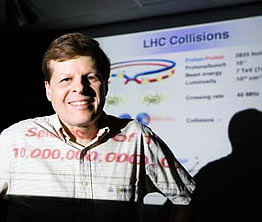Particle accelerator ready to attempt record-breaking collisions
Energy is building at the Large Hadron Collider outside of Geneva, Switzerland, in more ways than one.
As the particle accelerator gears up for the highest-energy particle collisions ever produced, physicists at the University of Wisconsin–Madison and around the world are excited to begin looking for evidence of new particles and other unexplained physics phenomena.
On Tuesday, March 30, the LHC will attempt the first collisions at 7 trillion electron volts (TeV) between two proton beams of 3.5 TeV each. These beams, first circulated in the machine on March 19, set a record for the highest energies yet reached in a particle accelerator.

Wesley Smith
Photo: Jeff Miller
See also: ‘Heart of the Matter,’ the cover story of the Fall 2008 issue of On Wisconsin magazine.
“As we increase the energy of the machine, we are able to make higher energy or higher mass particles and we are able to explore higher energy or higher mass phenomena that we couldn’t access with the lower energies,” explains UW–Madison physics professor Wesley Smith. Smith has helped develop one of the main experiments at the LHC, the Compact Muon Solenoid detector.
Though the anticipated collisions will only reach half the final intended energy of the LHC, they will be 3.5 times as powerful as the maximum capability of the next largest collider, the Tevatron Collider at the Fermi National Accelerator Laboratory in Batavia, Illinois, says Sau Lan Wu, the Enrico Fermi Professor of Physics at UW–Madison. Wu leads a group working on the ATLAS experiment, another of the large detectors, with associate professor of physics Yibin Pan and assistant professor of physics Bruce Mellado.
“The LHC leads us into a new and exciting regime of particle physics,” Wu says. “Our primary motivation is the discovery of new physics… and [we] are now eagerly waiting for the data.”
The proton beams circulating in the LHC’s 17-mile underground ring will collide inside four detectors, releasing showers of particles that scientists will analyze in search of fundamental insights into the nature of the physical world. The goals include the elusive Higgs boson, thought to give objects mass, and the hypothesized particles associated with a property called supersymmetry, a symmetry between matter and forces.
Since restarting in late 2009 after an electrical malfunction forced shutdown more than a year earlier, the LHC has been operating with lower energy proton beams to test and tune up the detectors and ensure it can safely ramp up to higher energies.
Once successful 7 TeV collisions are achieved, the LHC is expected to run at this energy level until around the end of 2011 before shutting down for upgrades needed to achieve even higher energy collisions.
The influx of data will be especially welcome news to the several UW–Madison physics graduate students whose theses and future careers will build on initial data from the LHC.
“This is opening up a new window on physics,” Smith says. “We will have a lot of data to analyze for new physics and to gain new perspective on many of the signals and phenomena that we’ve already observed in particle physics.”



